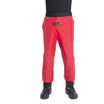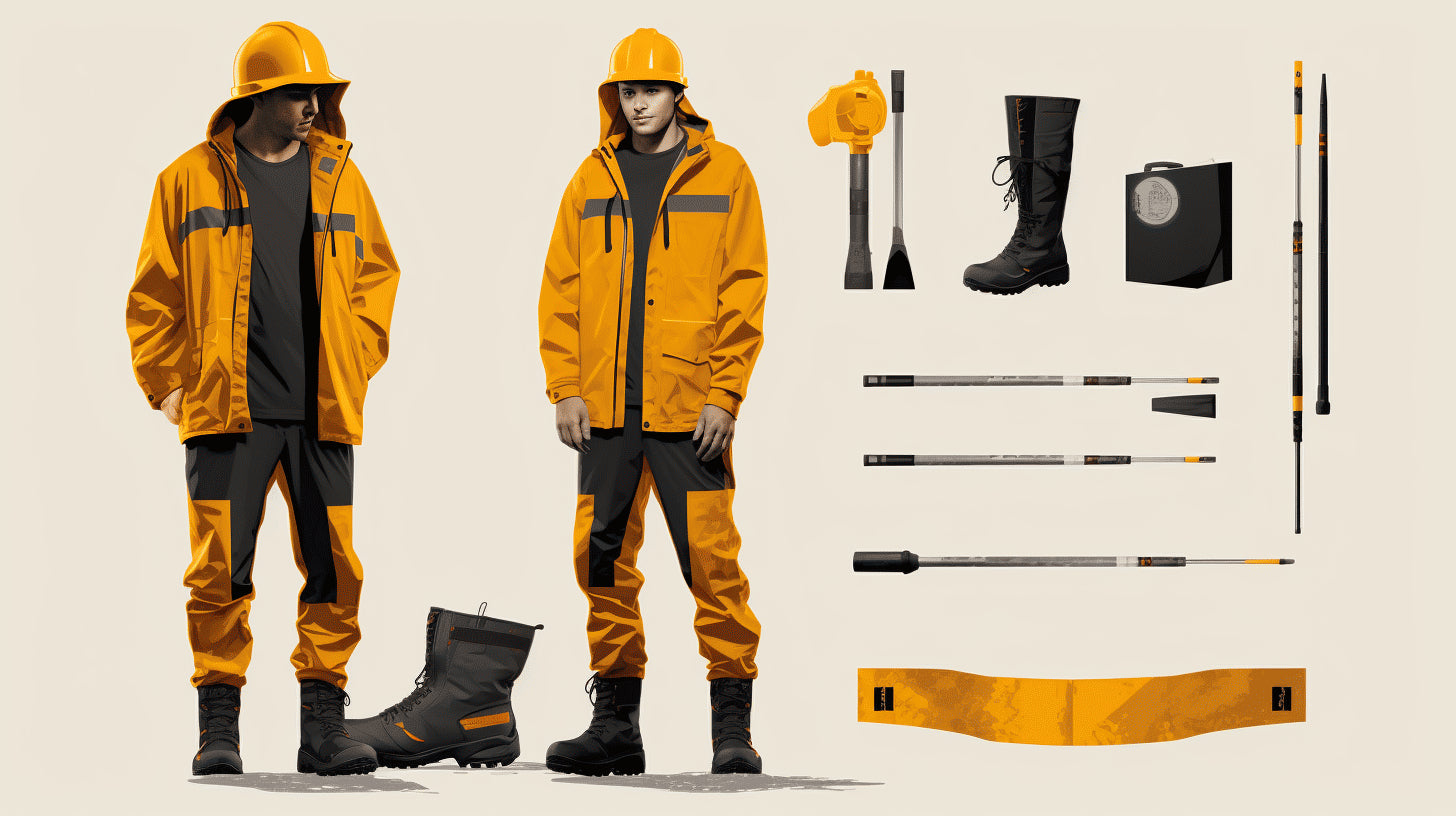Imagine you're a construction worker. The clock reads 7:00 AM. You rise, prepare for your day, and step outside. The sky is overcast, a soft drizzle blankets everything in sight. Unlike most people who dislike rainy days because they might mess up their hair or wet their clothes, your concern isn't about comfort, but safety. Working under such conditions is not just uncomfortable but can become perilous if you're not adequately equipped.
Here lies the essentiality of having proper rain gear. It's not just about keeping you dry; it also factors into productivity, safety, and overall job efficiency. This guide will explore the types of rain gear materials available, best practices for choosing construction rain gear, and make a few recommendations along the line. Explore this guide to understand why skimping on rain gear might be a risk not worth taking for construction workers. Let's delve in!
Understanding Rain Gear Materials
When it comes to gearing up for the rain, having the right materials can make all the difference. A major part of this is understanding the primary materials used in the manufacture of rain gear and how they compare in terms of waterproofing, durability, and breathability. In this article, we will delve into some of the major rain gear materials such as PVC, neoprene, urethane, rubber, Gore-Tex, and nylon, and unpack what you need to know about each one.
PVC Rain Gear
PVC, short for Polyvinyl Chloride, is one of the most commonly used materials for rain gear, especially for construction workers. This synthetic material is known for its exceptional waterproofing qualities, making it ideal for heavy rainfall. Manufactured rain gear for construction workers is broad and is often made with a blend of PVC and other materials to improve comfort and flexibility. Therefore, if you frequently find yourself working under heavy showers, PVC rain gear might be worth considering.
Neoprene Rain Gear
If PVC isn't your cup of tea, perhaps neoprene might suit you better. Neoprene is a type of synthetic rubber that is loved for its superior insulation and flexibility. It can efficiently trap heat, making it an excellent choice for cooler, wet weather. Additionally, just as synthetic rubber, neoprene also offers an outstanding level of waterproofing. Neoprene rain gear includes a variety of products, such as suits, gloves, and boots, furnishing you with a multitude of options to stay dry.
Urethane Rain Gear
Urethane-based rain gear, on the other hand, offers a blend of durability and elasticity. Despite often being light, it is incredibly resistant to abrasion and punctures. On top of that, urethane rain gear has efficient waterproofing capabilities and offers excellent breathability. These unique features make urethane an attractive choice for those who need flexibility and durability in their rain gear.
Rubber Rain Gear
Not to be overlooked, rubber offers tried-and-true material for rain gear. Renowned for its durability, rubber rain gear can withstand severe weather conditions and resist wear and tear, making it ideal for long-term use. However, rubber can be somewhat heavier and less breathable compared to other materials. Yet, its durability and 100% waterproof nature make rubber rain gear a standard choice for many.
Gore-Tex and Nylon Rain Jackets
Last but not least, let's consider Gore-Tex and nylon. Gore-Tex is a highly advanced material known for its superb breathability and water resistance. Meanwhile, nylon is another popular option that is primarily lauded for its lightweight and wind-resistant properties. Combined, these materials yield rain jackets which strike a balance between breathability, durability, water resistance, and lightness, making them an ideal choice for hikers and outdoor enthusiasts.
In conclusion, understanding the pros and cons of these materials enables you to make an informed choice about your rain gear. Choose the material that best suits your needs, and don't let the rain hinder your outdoor activities.
Best Practices for Choosing Construction Rain Gear
When you are caught in a downpour on a construction site, having the right rain gear can make all the difference. Not only can it keep you dry and comfortable, but it also can significantly improve your safety. In light of this, we will discuss some critical factors to consider when selecting rain gear for construction use. We'll delve into the superiority of triple-layer construction for protection, understand why high-visibility rain gear is indispensable, and explain why a DWR (Durable Water Repellent) finish is a game-changer.
Triple-Layer Construction for Protection
One of the most crucial aspects to look for when choosing construction rain gear is the type of material used and its construction. Specifically, triple-layer construction in rain jackets gives excellent protection. A three-layer jacket includes an outer layer that repels water, a middle layer that acts as a barrier for wind and water, and an inner layer that provides comfort and wicks away sweat.
This multiple layer approach ensures:
- Outer layer: Repels water, keeping the wind and rain out.
- Middle layer: Acts as a water and wind barrier, preventing these elements from reaching the innermost layer.
- Inner layer: Assists in managing moisture by wicking away sweat, thereby keeping you dry and comfortable.
By choosing a jacket with triple-layer protection, you can rest assured that you'll remain dry and comfortable, no matter how severe the weather conditions might be.
Importance of High-Visibility Rain Gear
Next on the list is to consider high-visibility clothing. On a busy construction site, visibility can mean the difference between safety and danger. High-visibility rain gear ensures that you will be seen even in the dreariest weather conditions. Fluorescent colors that stand out against natural backdrops and reflective strips that light up when hit by vehicle headlights are two common features of high-visibility clothing. This type of gear is essential for safety on construction sites where heavy machinery is being used, especially in poor visibility conditions.
Why DWR (Durable Water Repellent) Finish Matters
The final point to consider when buying construction rain gear is whether the material has a DWR (Durable Water Repellent) finish. This type of finish is applied to the outer layer of the fabric and works by making water bead up and roll off the surface, instead of soaking into the fabric.
It's important to note that DWR isn't waterproof, but it significantly enhances the material's ability to resist water. A DWR finish is invaluable in heavy rain, as it helps keep the outer layer of the material from becoming waterlogged and heavy. Plus, it ensures the garment dries quickly once the rain stops, maintaining comfort and utility throughout a long day on the site.
In summary, a construction worker's protection and safety can be dramatically enhanced by choosing rain gear with a triple-layer construction, high-visibility elements, and a DWR finish. Keep yourself dry, visible, and comfortable in any weather condition — because when you're well-protected, you can focus on the job at hand with confidence and peace of mind.
Top Recommendations for Rain Gear
In your quest to stay dry and comfortable in the rain while on construction sites, finding the right rain gear is crucial. Let's dive into our top recommendations, catering to various needs and price points. Whether you're seeking maximum waterproof capabilities or high visibility, there's a perfect choice for everyone.
Stay Protected with Urethane Rain Gear
Urethane rain gear is famously known for its lightness and breathability, making it a top pick for those stung by the stuffiness of traditional raincoats. The reflective fabric also makes it a smart choice for low-light conditions, ensuring you're seen no matter the weather.
Heavy-Duty Rain Gear
For those working in extreme weather conditions, heavy-duty rain gear is a must-have. Typically made from PVC or rubber, the strength and resilience of these options are unmatched. They might be a little heavier to wear, but the extra weight is a small price to pay for top-notch waterproofing.
Durable Rubber Rain Gear
Rubber rain gear is a classic choice. Renowned for its durability and reliability, it's ideal for construction workers who aren't afraid of a little bit of extra weight. While not the most breathable material, it guarantees you'll stay dry even in severe rainstorms.
Investing in Rain Ponchos
A rain poncho can be a lifesaver when rainstorms come without notice. Their lightweight and easy-to-don design make them a great addition to any construction worker's kit. While they aren't designed for heavy-duty use like some other options, they're perfect for those unexpected downpours.
The Value of Nylon-Backed PVC Rain Suits
A Nylon-Backed PVC Rain Suit combines the lightweight of nylon with the water resistance of PVC, offering comfort without sacrificing protection. They're more robust and durable than pure nylon suits, aiming to keep you dry in all but the most torrential rains. They also allow for maximum mobility, making them worth every penny.
Choosing the right rain gear involves understanding the unique needs of your project and weather conditions, combined with personal comfort preferences. Do not compromise on staying dry and safe while working, as this ensures you deliver best without risking your health. Making the right rain gear decision can truly be a gamechanger.
Frequently Asked Questions
-
What are the essential rain gear items for construction workers?
The essential rain gear items for construction workers include waterproof jackets, pants, and boots, as well as high-visibility raincoats, rain hats, and gloves.
-
Why is it important for construction workers to have rain gear?
Rain gear is important for construction workers as it helps keep them dry and protected from the elements. It also enhances visibility in rainy conditions, reducing the risk of accidents on worksites.
-
How do I choose the right rain gear for construction work?
When choosing rain gear for construction work, consider factors such as waterproofing capabilities, durability, breathability, comfort, and the ability to meet safety regulations. Look for gear specifically designed for construction and with high-visibility features.
-
Can rain gear be used in other weather conditions?
Yes, rain gear can be used in other weather conditions as well. Many rain jackets and pants are designed to be versatile and can provide protection against wind and cold, in addition to rain.
-
How should I care for my rain gear to ensure its longevity?
To ensure the longevity of your rain gear, follow the manufacturer's care instructions. Generally, it involves regular cleaning, avoiding harsh detergents, and maintaining the waterproofing properties by using specialized waterproofing sprays or wash-in treatments.























Leave a comment
This site is protected by hCaptcha and the hCaptcha Privacy Policy and Terms of Service apply.